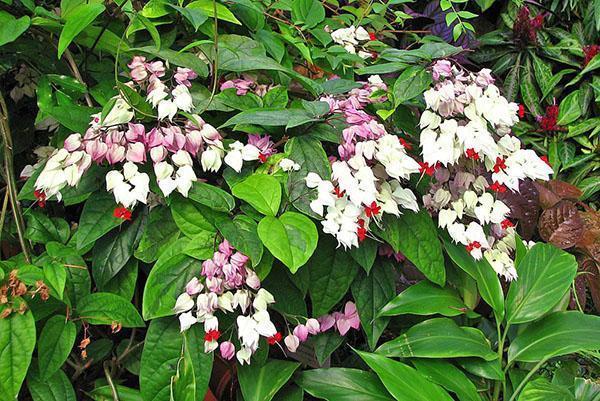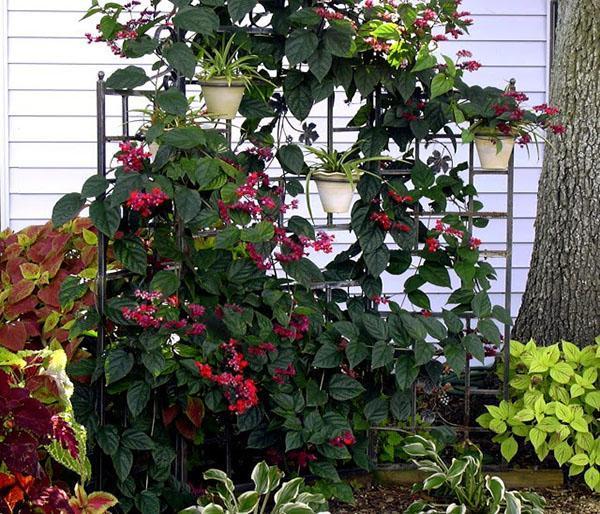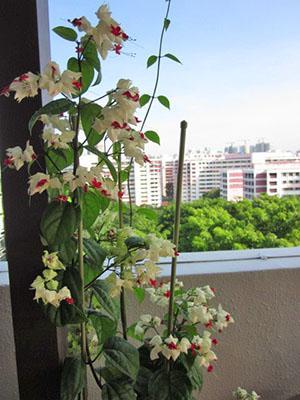Even a beginner can provide good care for Thompson's Clerodendrum
 Among clerodendrum there are many decorative, flowering plants, but not all of them take root as a house flower. Among the varieties that are ready to please flower growers with bright brushes is Thompson's clerodendrum, which is easy to care for at home and even beginners can do.
Among clerodendrum there are many decorative, flowering plants, but not all of them take root as a house flower. Among the varieties that are ready to please flower growers with bright brushes is Thompson's clerodendrum, which is easy to care for at home and even beginners can do.
Description of Thompson's Clerodendrum
The perennial liana came to the windowsills of Russian flower growers from the tropics of western Africa.
In a warm climate, without serious seasonal temperature fluctuations, the plants form shoots reaching 4 meters in length. In the room, such an overgrowth of Thompson's clerodendrum, as in the photo, will not work, and it is not necessary due to the limited space.
The main thing that draws attention to this decorative variety of clerodendrum is:
- "Quilted" ovate-pointed foliage, which, depending on the variety, can be dark green, variegated or even purple;
- racemose inflorescences consisting of 10–20 small 5-petal corollas surrounded by bulky bracts in the form of lanterns.

In place of flowers after pollination, small fruits of a yellow-orange hue appear. Inside each of them is one seed, which, when ripe, can be used to propagate Thompson's Clerodendrum.
Conditions for growing Clerodendrum Thompson at home
At home, the plant lives in partial shade under the crowns of trees. And at home, Thompson's clerodendrum, in the photo, is best placed on the east or west windows, under the cover of the loggia or deep into the room if the windows face south. The only place where the plant will be uncomfortable is on the north side. You can't do without additional illumination for the growing season and flowering, otherwise the ornamental culture will not be able to lay buds or their number will be negligible.
In order to achieve lush flowering and stable growth from a tropical vine, conditions close to natural must be created for it.
 In spring and summer, the shrub grows well at 18-24 ° C. By autumn and winter, the care of Thompson's clerodendrum, pictured, changes. A plant preparing for the winter sheds its foliage. To rest it is transferred to the coolness, where at 14-16 ° C the clerodendrum will stay until spring. If the ornamental shrubs are not arranged for a cool wintering or placed near heating devices, there is no need to wait for flowering in the next season.
In spring and summer, the shrub grows well at 18-24 ° C. By autumn and winter, the care of Thompson's clerodendrum, pictured, changes. A plant preparing for the winter sheds its foliage. To rest it is transferred to the coolness, where at 14-16 ° C the clerodendrum will stay until spring. If the ornamental shrubs are not arranged for a cool wintering or placed near heating devices, there is no need to wait for flowering in the next season.
A plant that has dropped its foliage consumes less moisture, does not need additional lighting and feeding.
Thompson's Clerodendrum Care
 From spring to late summer, caring for Thompson's clerodendrum at home consists of:
From spring to late summer, caring for Thompson's clerodendrum at home consists of:
- from regular watering;
- of top dressing, designed to increase the decorative effect of the shrub and maintain its strength during flowering.
It is necessary to moisten the soil under a perennial crop in such a way that from watering to watering the top layer dries out, but inside the earthen lump remains slightly moist. This will prevent the roots from rotting, which happens with excessive watering, or in a dry substrate, the aboveground part of the shrub withers. In winter, when Thompson's clerodendrum is resting, it should be watered very carefully and rarely, making sure that the soil does not completely dry out.
Watering is combined with top dressing from spring to the second half of summer, for which they use complex means for home flowering plants.
For a lush flowering when caring for Thompson's clerodendrum, it is better to take funds with a predominance of potassium and phosphorus. Nitrogen is useful only at the beginning of the growing season, when the crop is growing green mass.
Before the start of active spring growth, the plant is transplanted. Young specimens can be transferred into larger pots every year, while adults are transplanted at intervals of 2-3 years. If there is no urgent need for the procedure, you can replace only part of the substrate and prune the root system of Thompson's Clerodendrum.
 For all varieties of clerodendrum, a loose, slightly acidic soil rich in organic matter and nutrients is needed. Such a substrate can be made independently from humus, peat, coniferous land and sand. But if desired, the potting mix can be easily obtained from three parts of ready-made soil for flower crops and one part of an acidic substrate for azaleas.
For all varieties of clerodendrum, a loose, slightly acidic soil rich in organic matter and nutrients is needed. Such a substrate can be made independently from humus, peat, coniferous land and sand. But if desired, the potting mix can be easily obtained from three parts of ready-made soil for flower crops and one part of an acidic substrate for azaleas.
Pruning and breeding Clerodendrum Thompson
 The growth of shoots requires mandatory pruning and formation of the crown of the plant. The best time for this stage of caring for Thompson's Clerodendrum at home is early spring, when the green pet has not yet started to grow.
The growth of shoots requires mandatory pruning and formation of the crown of the plant. The best time for this stage of caring for Thompson's Clerodendrum at home is early spring, when the green pet has not yet started to grow.
The stems can be painlessly shortened by a third, which will only cause the awakening of inactive buds and the appearance of lateral shoots with new inflorescences. In adult specimens, even lignified stems are cut off, and young plants are pinched.
Apical cuttings with 2-3 pairs of formed leaves are easy to use for propagation of Thompson's Clerodendrum. They take root in water, and then are planted in a loose substrate under a film. After a month, when the seedlings are acclimatized, they are transferred to a permanent pot.
Pruning and shaping while caring for Thompson's Clerodendrum helps transform a natural vine into a compact shrub, a standard tree, or use the crop for vertical landscaping.